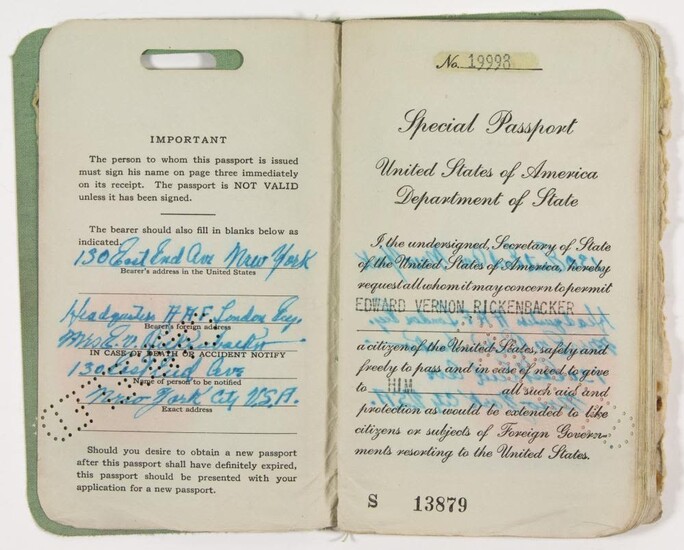EDWARD V. RICKENBACKER''S PASSPORT, CARRIED WHILE ON A LIFE RAFT FOR 21 DAYS
EDWARD V. RICKENBACKER (1890-1973) American aviator and World War I ace credited with 26 "kills", later president of Eastern Air Lines. A important historic relic, Rickenbacker's U.S. "Special Passport" as a "Government Official proceeding abroad on official business", issued to him and carried by Rickenbacker during his 21-day ordeal on a life raft in the South Pacific. The passport, issued on Sep. 17, 1942, contains visas showing Rickenbacker's travels to Prestwick in the U.K. shortly after issuance, and a visa from Australia just days before his disastrous flight. The document, as expected, water staining throughout, although the damage is limited to the blurring of ink. The passport photograph is lost, no doubt detached and ruined as a result of exposure to seawater. The adhesive binding the cover to the text also dissolved, hence covers are loose. Two typed card, also water damaged, are contained within, bearing the typed names and positions of Gen. Douglas MacArthur and high-level U.S. and Australian military leaders. The passport is accompanied by a copy of a 1997 notarized letter of provenance from Rickenbacker's son William F. Rickenbacker, describing the passport among other items placed in a private collection. WITH: a copy of a religious pamphlet signed by fellow survivor Flight Engineer JOHN BARTEK and a copy of the Nov. 15, 1942 report on the rescue signed by Navy Radio Operator LESTER BOUTTE who was on the scene. A most evocative relic! In late 1942 Secretary of War Henry Stimson and Army Air Forces chief of staff General Henry H. 'Hap' Arnold asked 52-year-old airline executive Edward "Eddie" Rickenbacker to travel to the Pacific theater to evaluate and report on the status of U.S. Army Air Forces combat units stationed there. On Oct. 20, 1942, he climbed aboard a B-17 in Hawaii bound for Canton Island, 1,800 miles to the south. Due to a faulty octant, the plane flew off course, ran out of fuel and ditched into the Pacific. There followed 21 days on a cramped lifeboat at sea, and the deaths of some of the crew. Rickenbacker, as senior officer, kept the men's spirits up while using his skills as a leader to improvise methods to ensure their survival.
[ translate ]View it on
Sale price
Estimate
Time, Location
Auction House
EDWARD V. RICKENBACKER (1890-1973) American aviator and World War I ace credited with 26 "kills", later president of Eastern Air Lines. A important historic relic, Rickenbacker's U.S. "Special Passport" as a "Government Official proceeding abroad on official business", issued to him and carried by Rickenbacker during his 21-day ordeal on a life raft in the South Pacific. The passport, issued on Sep. 17, 1942, contains visas showing Rickenbacker's travels to Prestwick in the U.K. shortly after issuance, and a visa from Australia just days before his disastrous flight. The document, as expected, water staining throughout, although the damage is limited to the blurring of ink. The passport photograph is lost, no doubt detached and ruined as a result of exposure to seawater. The adhesive binding the cover to the text also dissolved, hence covers are loose. Two typed card, also water damaged, are contained within, bearing the typed names and positions of Gen. Douglas MacArthur and high-level U.S. and Australian military leaders. The passport is accompanied by a copy of a 1997 notarized letter of provenance from Rickenbacker's son William F. Rickenbacker, describing the passport among other items placed in a private collection. WITH: a copy of a religious pamphlet signed by fellow survivor Flight Engineer JOHN BARTEK and a copy of the Nov. 15, 1942 report on the rescue signed by Navy Radio Operator LESTER BOUTTE who was on the scene. A most evocative relic! In late 1942 Secretary of War Henry Stimson and Army Air Forces chief of staff General Henry H. 'Hap' Arnold asked 52-year-old airline executive Edward "Eddie" Rickenbacker to travel to the Pacific theater to evaluate and report on the status of U.S. Army Air Forces combat units stationed there. On Oct. 20, 1942, he climbed aboard a B-17 in Hawaii bound for Canton Island, 1,800 miles to the south. Due to a faulty octant, the plane flew off course, ran out of fuel and ditched into the Pacific. There followed 21 days on a cramped lifeboat at sea, and the deaths of some of the crew. Rickenbacker, as senior officer, kept the men's spirits up while using his skills as a leader to improvise methods to ensure their survival.
[ translate ]


